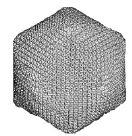Plant Pathology, Department of

James Van Etten Publications
Document Type
Article
Date of this Version
2005
Citation
Plant Pathal. J 21(4): 334-342 (2005)
Abstract
The prototype Chlorella virus PBCV-l encodes 11 tRNA genes and over 350 protein-encoding genes in its 330 kbp genome. Initial attempts to overexpress the recombinant A189/192R protein, a putative virus attachment protein, in E. coli strain BL21(DE3) SI were unsuccessful, and multiple protein bands were detected on Western blots. However, the full-length A189/192R recombinant protein or fragments derived from it were detected when they were expressed in E. coli BL21 CodonPlus (DE3) RIL, which contains extra tRNAs. Codon usage analysis of the a1891192r gene showed highly biased usage of the AGA and AUA codons compared to genes encoded by E. coli and Chlorella. In addition, there were biases of XXA/U (56%) and XXGI C (44%) in the codons recognized by the viral tRNAs, which correspond to the codon usage bias in the PBCV- 1 genome ofXXA/U (63%) over those ending in XXC/G (37%). Analysis of the codon usage in the major capsid protein and DNA polymerase showed preferential usage of codons that can be recognized by the viral tRNAs. The Asn (AAC) and Lys (AAG) codons whose corresponding tRNA genes are duplicated in the tRNA gene cluster were the most abundant (i.e., preferred) codons in these two proteins. The tRNA genes encoded in the PBCV-l genome seem to play a very important role during the synthesis of viral proteins through supplementing the tRNAs that are frequently used in viral proteins, but are rare in the host cells. In addition, these tRNAs would help the virus to adapt to a wide range of hosts by providing tRNAs that are rare in the host cells.


Comments
Copyright 2005 The Korean Society of Plant Pathology